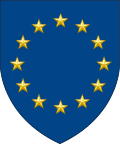Romanian Armed Forces
The Land Forces, Air Force and Naval Forces of Romania are collectively known as the Romanian Armed Forces (Romanian: Forțele Armate Române or Armata Română). The current Commander-in-chief is Lieutenant General Daniel Petrescu who is managed by the Minister of National Defence while the president is the Supreme Commander of the Armed Forces during wartime.
| Romanian Armed Forces | |
|---|---|
| Forțele Armate Române | |
 The coat of arms of the Romanian General Staff (until 2018) | |
| Founded | 1860 |
| Current form | 11 April 2000 |
| Service branches | |
| Headquarters | Bucharest |
| Leadership | |
| Supreme Commander of the Armed Forces | |
| Minister of National Defence | |
| Chief of the General Staff | |
| Manpower | |
| Military age | 18 |
| Conscription | No |
| Active personnel | 73,100 (2019)[1] |
| Reserve personnel | 53,000 (2019)[2] |
| Deployed personnel | 1,075 (2019)[3] |
| Expenditures | |
| Budget | $5.050 billion (2019)[1] |
| Percent of GDP | 2.04% (2019)[1] |
| Industry | |
| Domestic suppliers | Arms industry in Romania |
| Foreign suppliers | Current: Former: |
| Annual exports | €187,000,000 (2018)[4] |
| Related articles | |
| History | Military history of Romania |
| Ranks | Romanian Armed Forces ranks and insignia |
As of 2019, the Armed Forces number 69,600 active personnel and 53,000 reserves.[2] The Land Forces have a reported strength of 35,800, the Air Force 10,700, the Naval Forces 6,600, and Joint Forces 16,500.[2] Total defence spending currently accounts for 2% of total national GDP, which represents approximately 4.96 billion US dollars.[5] The Armed Forces are built for territorial defence, with contributions to NATO missions such as in Afghanistan a secondary priority.[5]
History of the Romanian Armed Forces
The first attempt to create an independent Romanian army was made by Gheorghe Magheru during the 1848 Wallachian Revolution, and it was based at Râureni (now part of Râmnicu Vâlcea). However, Magheru rapidly ordered his troops to disband when the Ottoman forces swept into Bucharest to stop the revolution.[6]
Romanian War of Independence
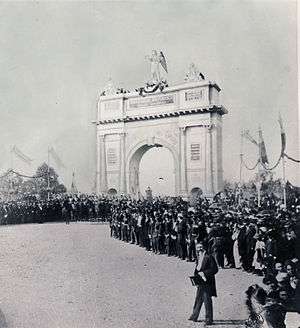
The current Romanian Land Forces were formed in 1859, immediately after the unification of Wallachia with Moldavia, and were commanded by Alexandru Ioan Cuza, Domnitor of Romania until his abdication in 1866. In 1877, at the request of Nikolai Konstantinovich, Grand Duke of Russia[7] the Romanian army fused with the Russian forces, and led by King Carol I, fought in what was to become the Romanian War of Independence. They participated in the Siege of Plevna and several other battles. The Romanians won the war, but suffered about 27,000 casualties. Until World War I, the Romanian army didn't face any other serious actions.
Second Balkan War
Romania mobilized its army on 5 July 1913, with intention of seizing Southern Dobruja, and declared war on Bulgaria on 10 July.[8] In a diplomatic circular that said, "Romania does not intend either to subjugate the polity nor defeat the army of Bulgaria", the Romanian government endeavoured to allay international concerns about its motives and about increased bloodshed.[8] According to Richard Hall, "the entrance of Romania into the conflict made the Bulgarian situation untenable and the Romanian thrust across the Danube was the decisive military act of the Second Balkan War."[9]
World War I

On July 6, 1916, Romania declared war on Germany and Austria-Hungary, following the initial success of the Brusilov Offensive (a major Russian offensive against the armies of the Central Powers on the Eastern Front). The Romanian armies entered Transylvania (then part of the Austro-Hungarian Empire), together with Russian forces. However, German forces under the command of General Erich von Falkenhayn stalled the attack in November, 1916, and drove back the Romanians. At the same time, Austrian and Turkish troops invaded southern Romania, forcing the country into a two-front war. The Central Powers drove deep into Romania and conquered the south of the country (Wallachia, including Bucharest) by the end of 1916. The Romanian forces, led by Marshal Constantin Prezan, retreated into the north-east part of Romania (Moldavia). In the summer of 1917 however, Prezan, aided by the future Marshal, General Ion Antonescu, successfully defended the remaining unoccupied territories against German and Austro-Hungarian forces led by Field Marshal August von Mackensen.[10] General Alexandru Averescu led the Second Army in the victories of the Battle of Mărăşti (July 22 to August 1, 1917) and the Battle of Mărăşeşti (August 6 to September 8, 1917). As a result of the Russian Revolution, Romania was left isolated and unable to continue the war, and was forced to sign the Treaty of Bucharest with the Central Powers.[11] Later on, in 1919, Germany agreed, in the Treaty of Versailles Article 259, to renounce all the benefits provided to it by the Treaty of Bucharest in 1918. After the successful offensive on the Thessaloniki front, which put Bulgaria out of the war, Romania re-entered the war on November 10, 1918, a day before its end in the West.[12]
World War II
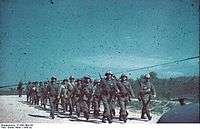
After General (later Marshal) Ion Antonescu took power in September 1940, Romania signed the Tripartite Pact with the Axis Powers and subsequently took part in Operation Barbarossa in 1941. An expeditionary force invaded the Soviet Union in Bessarabia and southern Ukraine, alongside the German Wehrmacht. The expeditionary force, 'Army Group Antonescu', was composed on 22 June 1941 of the 3rd Army, the 4th Army, the 2nd Army Corps, and the 11th Infantry Division.[13] The 3rd Army comprised the 4th Army Corps (6th and 7th Infantry Divisions), the Cavalry Corps, the Mountain Corps, two separate artillery battalion, a TA unit, and the Air Force's 3rd Army Cooperation Command. The 4th Army consisted of the 3rd Army Corps, the 5th Army Corps, the 11th Army Corps (two fortress brigades), and the 4th Army Cooperation Command. The army group-level 2nd Army Corps, under Major General N. Macici, controlled the 9th and 10th Infantry Divisions and the 7th Cavalry Brigade. Additionally the 1st Armoured Division was formed for service on the Eastern Front. The Army Group's first offensive, in conjunction with the Eleventh Army, Operation Munchen, enabled Romania to retake the territory immediately east of the Dnister, former part of Moldavia. The Romanian Armies saw their first major battles at Odessa and Sevastopol, and in 1942 advanced with other Axis forces deeper into Soviet territory during Operation Blue.
The greatest disaster for the Romanian expeditionary force on the Eastern Front came at Stalingrad, where, during the Soviet counter-offensive of November 1942, the thinly spread forces of the Third Army (deployed north of Stalingrad) and of the Fourth Army (deployed south of Stalingrad) were attacked by vastly superior Soviet forces and suffered combined losses of some 158,000 personnel.
During April–May 1944 the Romanian forces led by General Mihai Racoviţǎ, together with elements of the German Sixth Army were responsible for defending Northern Romania during the Soviet First Jassy-Kishinev Offensive, and took part in the Battles of Târgu Frumos. In late August 1944, the Red Army entered eastern Romania. The Battle of Jassy took place on August 20–25, 1944. 150 000 German soldiers died (80 000 in Stalingrad), 106 000 Germans was taken as prisoners by the Red Army (108 000 in Stalingrad); the fate of the rest 80 000 remain unknown. On August 23, 1944, a coup led by King Michael I of Romania deposed Marshal Antonescu and set up a pro-Soviet government. It has been estimated that the royal coup shortened the war by six months.[14] Romania soon declared war on Nazi Germany, and the First and Fourth Armies were pressed into action. After the expelling of the last Wehrmacht remnants from Romania, the Romanian Armies took part in the Siege of Budapest and the Prague Offensive of May 1945.
Cold War
After the Romanian Communist Party seized power, the Armed Forces of Romania was reformed to mirror the soviet model. It was reestablished as the Romanian People's Army (Romanian: Armata Populară Română) under the original supervision of Minister of Defence, Emil Bodnăraş. Between 1955 and 1991, the Romanian People's Army took part in events of the Warsaw Pact, of which Romania was a member. During this period, the army was supplied with weapons and equipment from the Soviet Union. From 1947 to 1960, the country divided into 3 military regions: Western (Cluj), Eastern (Bacău), and South (Bucharest).
In 1980 the Romanian Land Forces was reorganized in 4 Army Commands: 1st (Bucharest), 2nd (Buzau), 3rd (Craiova) and 4th (Cluj-Napoca). In the four Army Commands were 8 Mechanized Divisions, 2 Tank Divisions and 1 Tank Brigade, as well as 4 Mountain Brigades (specialized motorized infantry units).
In 1989 the RLF had, as armored equipment, a total of 2715 combat vehicles: 945 outdated (soviet WW-2 type) T-34-85 tanks, 790 soviet and Czechoslovak T-55/-55A/-55AM tanks, 415 Romanian built TR-77-580, 535 Romanian built TR-85-800 and 30 soviet T-72 "Ural-1" tanks.
Post-1990
The People's Army was dissolved after the Romanian Revolution in the beginning of 1990 and was rebranded as the Romanian Armed Forces. Since 1994, Romania has been actively participating in the Partnership for Peace program and on 29 March 2004, it officially joined the North Atlantic Treaty Organization (NATO). During the NATO bombing of Yugoslavia in 1999, Romania placed its territory and airspace at disposal for NATO troop and even sent troops to the Kosovo Force contingent in the summer of 1999 to stabilize the situation in Kosovo and Metohija. On 15 November 2002, Hungary, Romania, Slovakia, and Ukraine created a multinational engineering battalion called "Tisa" , which includes an engineering company from the armed forces.[15] Romania has taken part in the War in Afghanistan since July 2002, with Romanian contingent being increased from 962 to more than 1,500 troops in 2009.[16][17] The armed forces also took part in the War in Iraq from 2003 to August 2009, in which the losses of the Romanian contingent amounted to 3 soldiers killed and at least 11 wounded.
Equipment
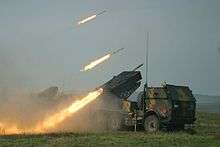

The Land Forces have overhauled their equipment in recent years, and are today a modern army with multiple NATO capabilities. They are participating in a peacekeeping mission in Afghanistan, together with the other NATO countries. The Land Forces are at present planning on replacing the TAB APC vehicles with new armored personnel carriers produced in conjunction with the Germany company Rheinmetall.[18] The Air Force currently operates modernized Soviet MiG-21 LanceR fighters, which are due to be replaced by modernized ex-Portuguese F-16 fighters starting with 2016. In the first stage a first squadron of 12 fighter aircraft will be acquired and a second squadron of another 12 aircraft [19][20] will follow by 2020. The Air Force has also received 7 new C-27J Spartan tactical airlift aircraft, in order to replace the bulk of the old transport force.[21] Two modernized ex-Royal Navy Type 22 frigates were acquired by the Naval Forces in 2004 and a further four modern missile corvettes will be commissioned in the next few years. Three domestically-produced IAR 330 Puma NAVAL helicopters were also ordered by the Naval Forces, and were commissioned in late 2008.
Manpower
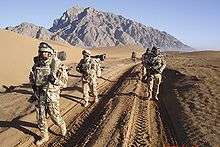
Romania joined NATO in 2004. As a consequence, extensive preparations were made to abolish conscription by 2007 and create a professional army in place of a conscripted one.
The new armed forces include 69,600 military personnel.[2] Some 35,800 make up the Romanian Land Forces, 10,700 serve as the Romanian Air Force and 6,600 are in the Romanian Naval Forces; the remaining 16,500 serve in other fields.[2]
Future
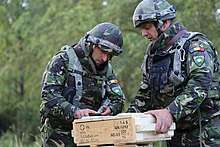
The Romanian Military will essentially undergo a three-stage restructuring. As of 2017, the first two stages have been completed. 2015 marked the end of the second stage when the armed forces reached a superior compatibility with NATO forces.[22] In 2025, the long-term stage is to be completed. The stages aim at modernising the structure of the armed forces, reducing the personnel as well as acquiring newer and more improved technology that is compatible with NATO standards.[22]
The military sees obsolete Soviet-era equipment as a major limitation and intends to replace its MiG-21 fighters by 2020 and buy modern combat helicopters, according to an August 2017 government plan.[23] Romania is also set to acquire the MIM-104 Patriot air defence system, armored vehicles, corvettes and US M142 HIMARS rocket artillery.[5]
Current deployments
Romanian troops participated in the occupation of Iraq, reaching a peak of 730 soldiers before being slowly drawn down to 350 soldiers. Romania terminated its mission in Iraq and withdrew its last troops on July 24, 2009.
Romania currently has troops deployed in Afghanistan, and is planning to nearly double its troop strength there to 1,800 by September 2010, according to an announcement made by President Traian Basescu in Prague on April 8, 2010.[24]
Other militarized institutions
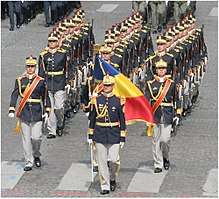
The following Romanian institutions have military status but are not part of the Armed Forces:
- Romanian Gendarmerie (Jandarmeria Română), subordinated to the Ministry of Administration and Interior;
- Inspectoratul General al Corpului Pompierilor Militari (Military Firefighters) and Comandamentul Protecției Civile (Civil Defence), merged into the Romanian Inspectorate for Emergency Situations within the Ministry of the Interior;
- Inspectoratul General de Aviație (General Aviation Inspectorate) within the Ministry of the Interior
- Serviciul Român de Informații (Romanian Intelligence Service);
- Serviciul de Protecție și Pază (Protection and Guard Service, provides protection to Romanian and foreign officials);
- Serviciul de Telecomunicații Speciale (Special Telecommunications Service);
- Serviciul de Informații Externe (Foreign Intelligence Service).
See also
- List of the Chiefs of the General Staff of Romania
- List of generals of the Romanian Armed Forces
- List of countries by number of active troops
- Foreign relations of Romania
- Equipment of the Romanian Armed Forces
- Romanian Land Forces
- Romanian Air Force
- Romanian Naval Forces
Citations
- "Defence Expenditure of NATO Countries (2013-2019)" (PDF). NATO Public Diplomacy Division. 29 November 2019. Retrieved 12 December 2019.
- IISS 2020, p. 139.
- IISS 2020, p. 140.
- Archived 2015-01-18 at the Wayback Machine Gandul, 13 January 2015.
- IISS 2020, p. 138.
- (in Romanian) Liviu Maior, 1848-1849. Români şi unguri în revoluţie (Romanians and Hungarians in the revolution), Bucharest, Editura Enciclopedică, 1998.
- The telegram of Nikolai to Carol I (in Romanian): "Turcii îngrãmãdind cele mai mari trupe la Plevna ne nimicesc. Rog sã faci fuziune, demonstratiune si dacã-i posibil sã treci Dunãrea cu armatã dupã cum doresti. Între Jiu si Corabia demonstratiunea aceasta este absolut necesarã pentru înlesnirea miscãrilor mele" ("The Turks massed together the greatest troop at Pleven to lay us waste. I ask you to make mergers, demonstrations and if it is possible cross the Danube with the army as you wish. Between Jiu and Corabia, the demonstration is absolutely necessary to facilitate my movements.)
- Hall (2000), p. 117.
- Hall (2000), pp. 117–18.
- Vincent Esposito, Atlas of American Wars, Vol 2, text for map 40
- John Keegan, World War I, pg. 308.
- World War I Documents, Articles 248-263 Archived 2007-12-10 at the Wayback Machine. Retrieved on February 28, 2008.
- Leo Niehorster, Army Group Antonescu, 22 June 1941 Archived 5 March 2016 at the Wayback Machine, accessed June 2011
- Constantiniu, Florin, O istorie sinceră a poporului român ("An Honest History of the Romanian People"), Ed. Univers Enciclopedic, Bucureşti, 1997, ISBN 973-9243-07-X.
- Румыния полностью вывела свои войска из Ирака // REGNUM.RU от 21 августа 2009
- Румыния // «Зарубежное военное обозрение», № 9 (798), сентябрь 2013. стр. 91
- Tony Perry. Romania shows its support for the U.S.-led mission in Afghanistan // «Los Angeles Times» от 19 августа 2010
- Adamowski, Jaroslaw (8 August 2017). "Romania to Award Armored Vehicles Deal to Germany's Rheinmetall".
- Marica, Irina (22 February 2016). "Romania to buy more F-16 fighters next year - Romania Insider". Archived from the original on 26 March 2016. Retrieved 18 March 2016.
- http://www.airforce-technology.com/news/newsromania-to-acquire-f-16-fighter-jets-4821598%5B%5D
- "Spartan Order", Aviation Week & Space Technology, December 11, 2006.
- Ministry of National Defence, Strategia de transformare a Armatei României ("Strategy for the transformation of the Romanian Army") Archived 2008-02-16 at the Wayback Machine
- IISS 2018, p. 140.
- YAHOO News, WHITE HOUSE NOTEBOOK: Obama in Prague
References
- IISS (2020). The Military Balance 2020. Routledge. ISBN 978-0367466398.
Further reading
- Daniel N. Nelson, 'Armies, Security, and Democracy in Southeastern Europe,' Armed Forces & Society, Vol. 28, No.3, Spring 2002.
External links
| Wikimedia Commons has media related to Military of Romania. |
- (in English) Official site of the Romanian Ministry of Defence (MoD)
- (in English) Official site of the Romanian General Staff
- (in English) Official site of the Romanian Land Forces
- (in English) Official site of the Romanian Air Force
- (in English) Official site of the Romanian Naval Forces
- New U.S. Base in Romania To Be Larger Than Previously Estimated, ThePeacockReport.com, Oct. 11, 2006.

